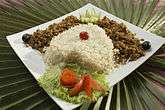Steamed rice

Steamed rice refers to rice that has been cooked either by steaming[1] or boiling. Steamed rice includes any variant, including short, medium, and long grain rice.
Rice is a staple food in not only Asia and Latin America, but across the globe, and is considered the most consumed food in the world. The U.S. Department of Agriculture classifies rice as part of the grains food group -- each cup of cooked steamed white rice contributes 2 ounces toward the daily recommended 6 and 7 ounces for women and men, respectively, and is considered a good source of micronutrients such as zinc and manganese.[2]
Preparation
| Nutritional value per 100 g (3.5 oz) | |
|---|---|
| Energy | 544 kJ (130 kcal) |
|
29 g | |
| Sugars | 0 g |
| Dietary fiber | 0 g |
|
0 g | |
|
2.4 g | |
| Vitamins | |
| Thiamine (B1) |
(17%) 0.2 mg |
| Riboflavin (B2) |
(0%) 0.0 mg |
| Niacin (B3) |
(10%) 1.5 mg |
| Pantothenic acid (B5) |
(8%) 0.4 mg |
| Vitamin B6 |
(13%) 0.164 mg |
| Minerals | |
| Calcium |
(0%) 1 mg |
| Iron |
(12%) 1.5 mg |
| Magnesium |
(2%) 8 mg |
| Manganese |
(19%) 0.4 mg |
| Phosphorus |
(5%) 33 mg |
| Potassium |
(0%) 23 mg |
| Zinc |
(4%) 0.4 mg |
| Other constituents | |
| Water | 68.5 g |
| |
|
Percentages are roughly approximated using US recommendations for adults. Source: USDA Nutrient Database | |
Steamed rice is traditionally prepared in one of two ways. Actual steaming is done by placing a bowl or pot containing dry rice, along with some water that will be absorbed, into a food steamer, and cooking it until done. Steamed rice is normally cooked by adding dry rice and a small amount of salt to water and boiling it in a covered pot. Today, most rice is prepared in electric rice cookers, that work the same way. During cooking, the rice absorbs the water, increasing in volume and mass. The rice is considered cooked when it has absorbed all the water.
Use in dishes
In China, steamed rice is most commonly served in individual bowls, with each diner receiving one. Food from communal dishes is placed upon the rice, and is then eaten.
Steamed or boiled rice is used as an ingredient in many dishes. In China, leftover steamed rice is used to make porridge eaten the following morning. In Indonesia, leftover steamed rice is used to make nasi goreng for breakfast in the morning. Some other dishes include:
- Bamboo rice, a Chinese dish where rice is steamed inside a segment of bamboo, a Cambodian version is called Kralan.
- Dal bhat, a traditional India and Nepali staple dish.
- Fried rice, an Indonesian version is called nasi goreng.
- Nasi campur, an Indonesian 'mixed rice', surrounded by assorted Indonesian dishes, Balinese version is called nasi Bali.
- Nasi kuning, an Indonesian 'yellow rice', a turmeric colored steamed rice.
- Nasi lemak, a Malay steamed rice cooked in coconut milk, Indonesian version is called nasi uduk.
- Onigiri, a Japanese rice ball, similar Indonesian version is called lemper.
- Puto, a Philippine steamed rice cake.
- Red beans and rice
- Rice and beans
- Rijsttafel, a Dutch 'rice table', derived from Indonesian cuisine during colonial times.
- Sushi, a Japanese vinegared rice with raw fish or other ingredients.
- Tteok, a type of Korean rice cake
- Tumpeng, a Javanese cone shaped steamed rice surrounded by assorted dishes.
- Zongzi, a traditional Chinese dish using glutinous rice steamed inside a leaf or bamboo.
- Claypot rice, a traditional Chinese dish where the rice is cooked inside the claypot (charcoal stove).
- Bibimbap, a signature Korea mixed rice.Usually served with white rice, vegetables, soy sause, eggs, gochujang and others.
- Spanish rice, a mexico side dish which is made from rice, tomato and chili pepper.
Use in beverages
- Makgeolli (막걸리), a Korean alcoholic rice wine.
- Sake (酒), a Japanese alcoholic beverage.
- Yuk Bing Siu Zau (玉冰燒酒), a Cantonese alcoholic rice wine.
Varieties
Most common is plain, steamed white rice; however, a number of varieties and are served, many with specific cooking methods. Some varieties include:
- Thai steamed rice
- Sticky rice
- Sushi rice (cooked with the addition of Japanese rice vinegar and sugar)
- Basmati rice
- Original Steamed Fried Rice – Freshly cooked or aged rice stir-fried with garlic, then topped with a thick savory sauce laden with either beef, chicken or pork, shrimp and green peas, seasoned with Cebu's version of Patis and Soy Sauce. This is typical in most Dim Sum presentations throughout the Philippines. It was believed to be brought by Chinese immigrants from outside the country during the early 1900s and was considered to start in Cebu City. It is uncommon to the traditional Dim Sum that originated in China.[3]
Gallery

- A steamed rice cake
- Boiled rice
- A Japanese bamboo glutinous rice steamer
 A modern rice cooker
A modern rice cooker Non-glutenous steamed black rice
Non-glutenous steamed black rice
See also
References
- ↑ Shiok - Chef's Notes: How to make perfect steamed rice
- ↑ "What Are the Benefits of Steamed White Rice?". Healthy Living - azcentral.com. Retrieved 2016-01-28.
- ↑ Michelle Ignacio. "Recipe for Cebu Style Steamed Rice". Certified Foodies. Retrieved 14 December 2014.
External links
| Wikimedia Commons has media related to Steamed rice. |
| Wikibooks Cookbook has a recipe/module on |